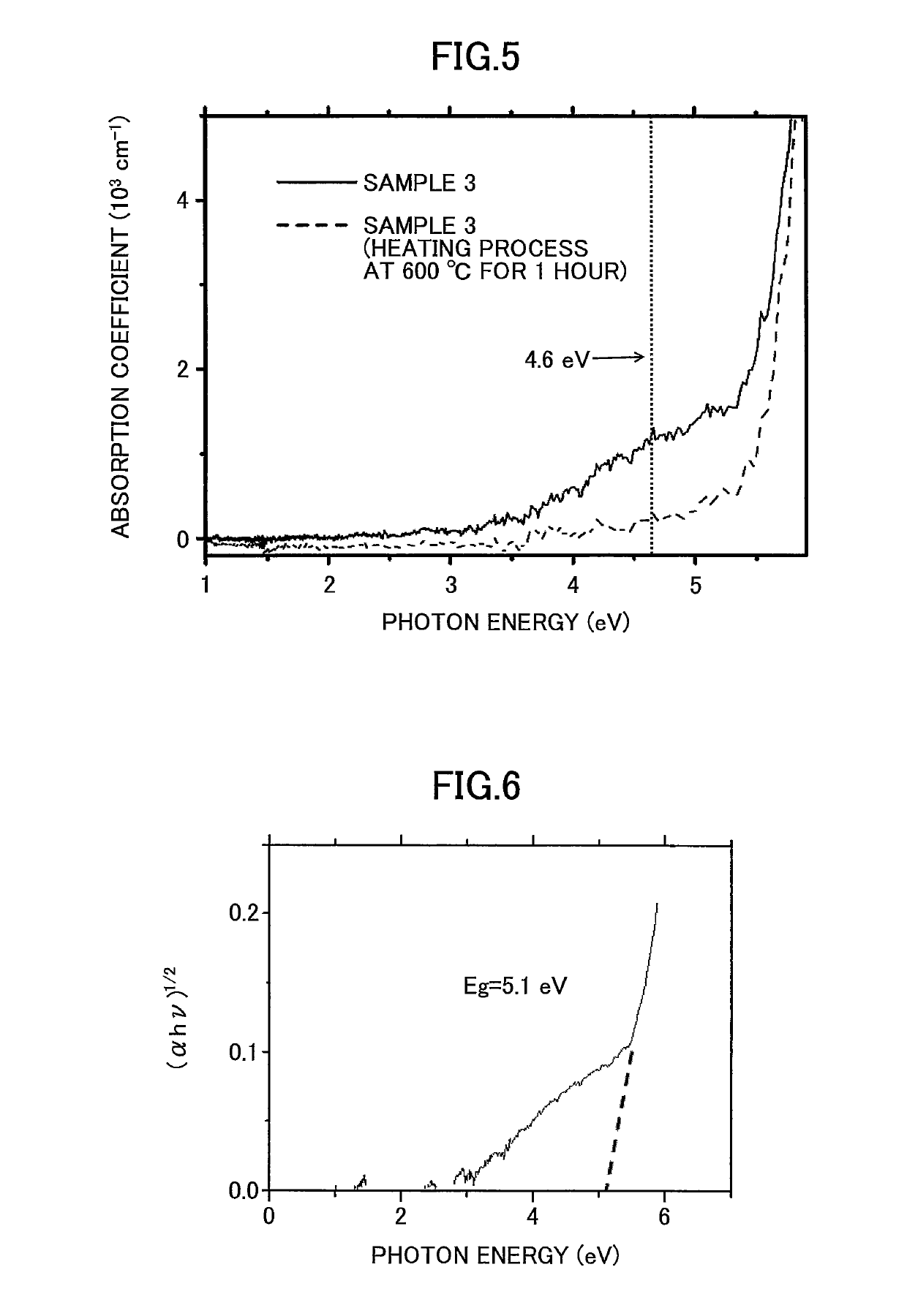C12A7 electride thin film fabrication method and C12A7 electride thin film
a technology of electride and thin film, which is applied in the direction of oxide conductors, non-metal conductors, vacuum evaporation coatings, etc., can solve the problems of inconvenient method for fabricating a crystalline c12a7 electride thin film, the combination of materials that may be used for the thin film and the substrate may be very limited, and the heat resistance of materials that may be used as the substrate may be limited
- Summary
- Abstract
- Description
- Claims
- Application Information
AI Technical Summary
Benefits of technology
Problems solved by technology
Method used
Image
Examples
example 1
Target Fabrication
[0133]First, a raw material powder was obtained by preparing and mixing CaO powder and Al2O3 powder to a molar ratio of 12:7. The raw material powder was heated to 1350° C. in air to fabricate a bulk of crystalline C12A7.
[0134]Then, the crystalline C12A7 bulk was pulverized into powder, and the powder was press-molded through cold isostatic pressing to obtain a crystalline C12A7 molded body. Further, the molded body was placed in a carbon crucible together with metal aluminum and heated to in a vacuum furnace. In the carbon crucible, the molded body and the metal aluminum were separately held. The temperature was heated to 1300° C. and held for 6 hours, and in this way, a crystalline C12A7 electride sintered body was obtained.
[0135]The sintered body was then cut into a disk shape with a thickness of 5 nm and a diameter of 3 inches, and the disk-shaped sintered body was fixed to a Cu backing plate using In to obtain a sputtering target (simply referred to as “target...
example 2
[0167]Sample 6 was fabricated by forming an amorphous C12A7 electride thin film on a substrate in the same manner as the above Example 1. However, in Example 2, the pre-sputtering process using He gas was not conducted. Instead, before using the crystalline C12A7 electride target, the surface of the crystalline C12A7 electride target was polished with a diamond file. Note that the sputtering process using Ar gas was conducted for 2 hours in the present example. Other processing conditions were the same as those used for fabricating Sample 1 of Example 1.
[0168]FIG. 7 illustrates internal transmittance measurement results of Sample 6. Note that in FIG. 7, the internal transmittance measurement results of Sample 2 is indicated along with the internal transmittance measurement results of Sample 6.
[0169]As can be appreciated from FIG. 7, a substantial decrease in transmittance could be observed in Sample 6 at the position of the photon energy of 4.6 eV.
[0170]Thus, it could be confirmed t...
example 3
[0171](Work Function of Amorphous C12A7 Electride Thin Film)
[0172]A sample (Sample 7) having an amorphous C12A7 electride thin film with a thickness of 10 nm formed on an ITO was fabricated by performing the sputtering process for 4 minutes using a glass substrate with ITO (indium tin oxide) instead of a silica glass substrate. Note that other than the above processing conditions, Sample 7 was fabricated in the same manner as Example 1.
[0173]The work function of Sample 7 was measured by ultraviolet photoelectron spectroscopy. In order to obtain a clean surface, measurement was performed under ultra-high vacuum (10−7 Pa), and organic matter was removed from the surface by Ar sputtering before measurement. Also, X-ray photoelectron spectroscopy was performed before and after the Ar sputtering process to confirm that the thin film sample has not been damaged. Further, a DC voltage (bias voltage) was applied to Sample 7 so that Sample 7 may be at a negative potential with respect to the...
PUM
| Property | Measurement | Unit |
|---|---|---|
| electron density | aaaaa | aaaaa |
| electron density | aaaaa | aaaaa |
| partial pressure | aaaaa | aaaaa |
Abstract
Description
Claims
Application Information
 Login to View More
Login to View More - R&D
- Intellectual Property
- Life Sciences
- Materials
- Tech Scout
- Unparalleled Data Quality
- Higher Quality Content
- 60% Fewer Hallucinations
Browse by: Latest US Patents, China's latest patents, Technical Efficacy Thesaurus, Application Domain, Technology Topic, Popular Technical Reports.
© 2025 PatSnap. All rights reserved.Legal|Privacy policy|Modern Slavery Act Transparency Statement|Sitemap|About US| Contact US: help@patsnap.com



